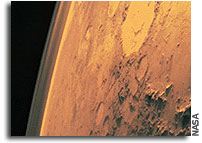Model Methanogens

Researchers test the viability of methane-producing microorganisms on different types of soils similar to those found on Mars.
FAYETTEVILLE, Ark. — University of Arkansas researchers have tested the methane production of three different types of microorganisms in different soil types that resemble those found on Mars to test the possibility of these soils harboring life.
Tim Kral, professor of biological sciences at the University of Arkansas; Heaven A. Kozup of Gwynedd-Mercy College in Pennsylvania, and UA graduate student Brandon G. Gibson will present their findings Wednesday, May 23, at the American Society for Microbiology in Toronto.
“We had found that methanogens can grow on Mars soil stimulant, but we didn’t know if they could grow on other types of soils found on Mars,” Kral said.
For years Kral has studied methanogens, ancient microorganisms from the biological domain Archaea, as potential candidates for what life might look like on Mars. At first glance, Mars appears unfriendly toward most life forms. The planet currently contains no detectable organic matter and has extremely cold surface temperatures. However, methanogens seem to be a potential candidate for what life on Mars might look like — they produce methane and live in harsh, anaerobic environments, such as the guts of animals, in deep parts of the ocean or in the Earth’s crust.
Kral, Kozup and Gibson cultured three different species of methanogens on five different substrates — clay, sand, gravel, basalt and Mars soil stimulant — in sealed anaerobic culture tubes. They used glass beads as a control substrate. All of the tubes contained hydrogen as an energy source and carbon dioxide as a carbon source. The researchers then measured the methane production from each test tube for a month.
“We wanted to see if different types of rocks and soils could supply the other necessary ingredients for them to produce methane,” Kral said. The test tubes containing sand, gravel and Mars soil stimulant all produced methane, indicating the presence of living methanogens. Only one species of methanogen produced methane on basalt, which is commonly found in Martian soil, and none was found in the clay, although Kral plans to re-create the experiments in a slightly different manner.
“This is a hodgepodge of things that come together and tell a story,” Kral said. “You have to put the parts in place before you can see the whole picture. We are currently teasing out the parts so we can build the picture.”
Kral is a professor of biological sciences in the J. William Fulbright College of Arts and Sciences.
ASM presentation: “Methane Production on Rock and Soil Substrates by Methanogens: Implications for Life on Mars.” (Session 184/N, Paper N-160)
Contact:
Tim Kral, professor, biological sciences
J. William Fulbright College of Arts and Sciences
(479) 575-6338
Melissa Lutz Blouin, director of science and research communications
University Relations
(479) 575-5555









